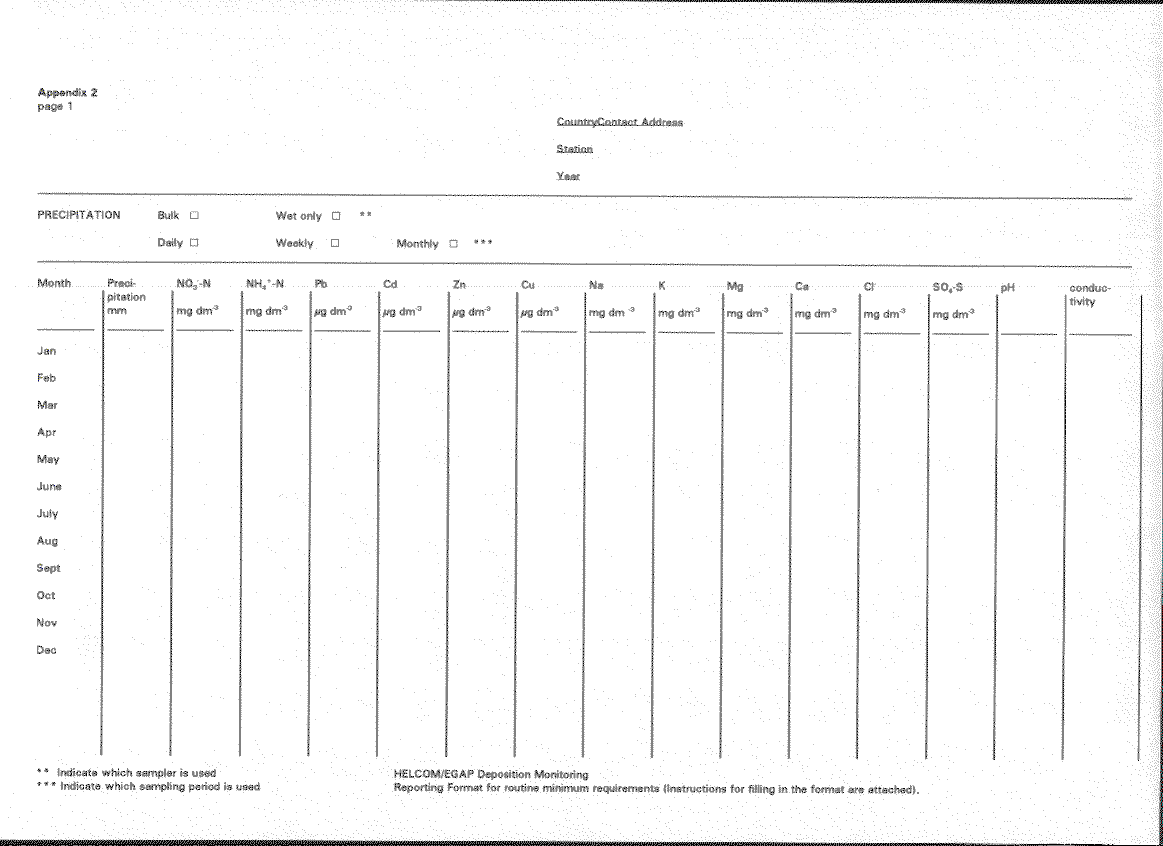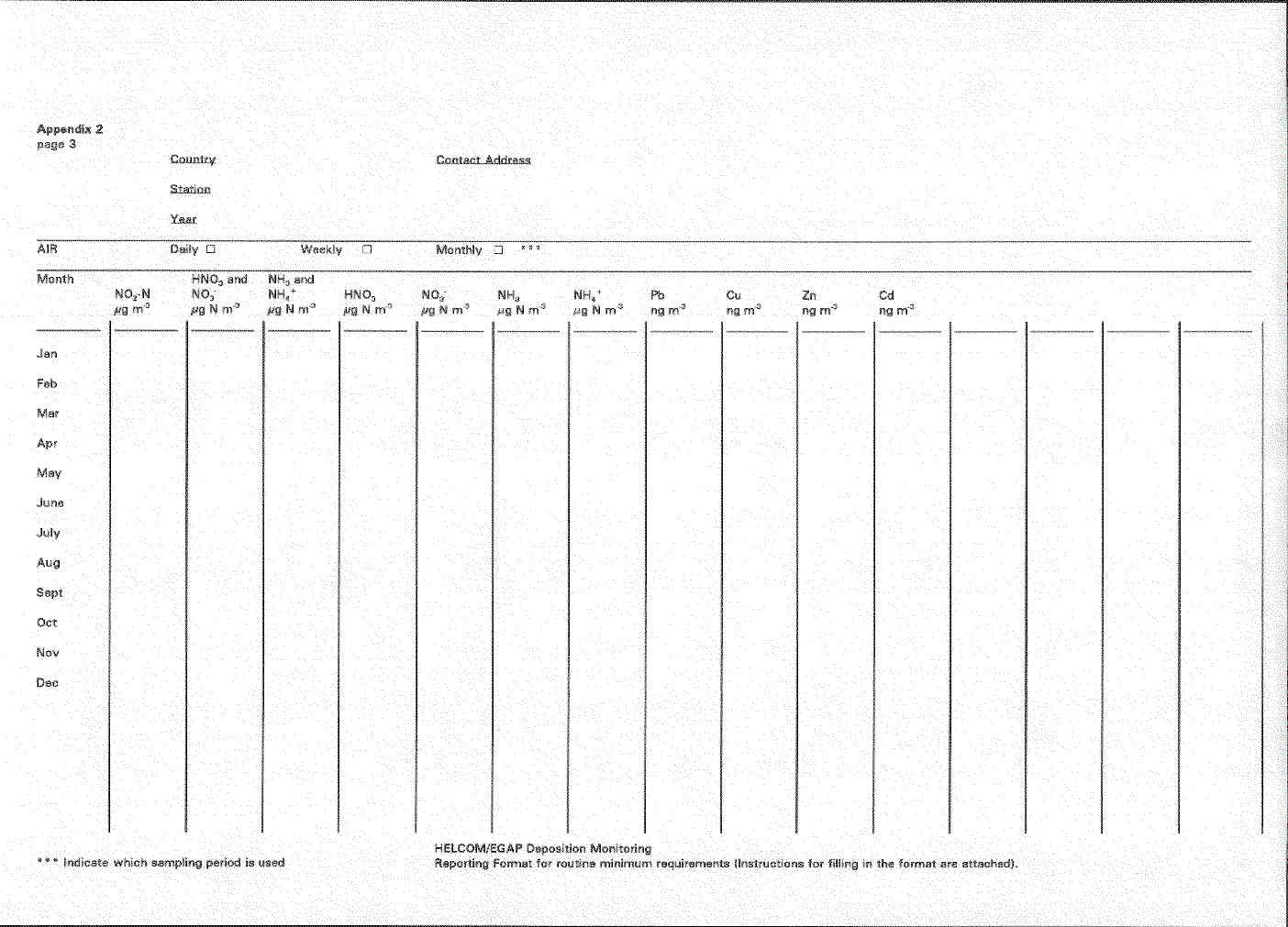HELCOM RECOMMENDATION 14/1
Adopted 3 February 1993, having regard to Article 13, Paragraph b) of the Helsinki Convention
This Recommendation supersedes HELCOM Recommendation 11/1
MONITORING OF AIRBORNE POLLUTION LOAD
THE COMMISSION,
RECALLING Article 6 of the Convention on the Protection of the Marine Environment of the Baltic Sea Area, 1974 (Helsinki Convention), in which the Contracting Parties undertake to take all appropriate measures to control and minimize land-based pollution of the marine environment of the Baltic Sea Area, and to endeavour to use best practicable means in order to minimize the airborne pollution of the Baltic Sea Area by noxious substances,
RECALLING ALSO Paragraph 3 of the Article 16 of the Helsinki Convention, in which the Contracting Parties undertake directly, or when appropriate, through competent regional or other international organizations and other basis of information and data acquired pursuant to Paragraphs 1 and 2 of Article 16, to cooperate in developing intercomparable observation methods, in performing baseline studies and in establishing complementary of joint programmes for monitoring,
NOTING the increasing concern on harmful effects on pollutants in the environment and that an essential amount of various contaminants is transported via the atmosphere,
NOTING FURTHER the decision by the Commission to start joint monitoring programme as adopted as the HELCOM Recommendation 7/1,
DESIRING to limit the pollution of the Baltic Sea due to atmospheric transport of harmful substances,
BEING MINDFUL of the need of reliable data on the amounts of harmful substances carried by the air to the Baltic Sea,
RECOMMENDS to the Governments of the Contracting Parties to the Helsinki Convention that:
a)each Baltic Sea State should have at least one monitoring station on the sea (or on the coast), to be included in the joint monitoring programme;
b)the list attached to this Recommendation (Appendix 1) should be used as the basis for the monitoring programme in all Baltic Sea States, bearing in mind that the list contains minimum requirements;
c)in order to substantiate monitoring methods for persistent organic pollutants emitted primarily to air, corresponding research activities should be encouraged in the Baltic Sea States; and
d)whenever possible, also experimental monitoring of those substances which are now included in the present list attached to this Recommendation, should by started,
RECOMMENDS ALSO that all laboratories involved would apply reliable analytical procedures taking into account also the development in other relevant international organizations concerning analytical, technological and data quality assurance,
RECOMMENDS FURTHER that as a prerequisite for accomplishing reliable estimates from suitable dispersion and deposition models for atmospheric inputs to the Baltic Sea Area of harmful substances, emissions inventories should be appropriately provided by all Baltic Sea States on these relevant substances. The purpose of such estimates is to establish an assessment of inputs for which priority control action should be taken, and to facilitate decisions concerning emission reductions,
RECOMMENDS FURTHERMORE that the Baltic Sea States would report their monitoring data to the Commission or to the consultant in charge of the data bank using the
form attached to this Recommendation (Appendix 2),
RECOMMENDS FURTHERMORE that:
a)the annual monitoring data be submitted 1 July of the following year to the Secretariat or to the consultant;
b)the methodological and other relevant additional information concerning monitoring be submitted every third year/or when there will be changes in the methods or in the monitoring network, following the procedure started in 1986 and using the form
attached to this Recommendation (Appendix 3); and
c)The emissions inventories be submitted for 1990 and updated as appropriate by the Baltic Sea States, and be based on a methodology harmonized with other relevant international bodies.
_________________________________________________________________________________________________
Appendix 1
| RECOMMENDED LIST OF PARAMETERS FOR THE MONITORING OF AIRBORNE POLLUTION LOAD | |||
| Monthly concentration values | Routine Minimum Requirements | Experimental | |
| N | NO- precipitation | + | |
| NH4+ precipitation | + | ||
| NO2 gas | + *) | ||
| HNO3 gas + NO3- | HNO3 gas | ||
| particles | + *) | NO3- particles | |
| NH3 gas + NH4+ | NH3 gas | ||
| particles+ *) | + *) | NH4+ particles | |
| Pb | precipitation | + *) | |
| particles | - | + | |
| Cd | precipitation | + *) | |
| particles | - | + | |
| Cu,Zn | precipitation | + *) | |
| particles | - | + | |
| Cr | |||
| Ni | |||
| As | precipitation | ||
| Hg | - | + | |
| POP** | precipitation | + | |
| + | monitored on routine or experimental basis | ||
| - | not monitored on routine basis | ||
| *) | monitored on routine basis, from at least one station of each country | ||
| **) | Persistent Organic Pollutants selected from the Baltic Sea priorty list of harmful substances that are emitted primalrily to air | ||
| For quality assurance purposes the Countries are encouraged to report the concentrations in precipitation of the major ions: (Na, K, Ca, Mg, SO4=, Cl- pH and electrical conductivity) | |||
___________________________________________________________________________________________________
Appendix 2
Page 4
TENTATIVE INSTRUCTIONS FOR REPORTING MONITORED DATA TO THE BALTIC MARINE ENVIRONMENT PROTECTION COMMISSION
Monthly mean values should be reported in the following way:
Precipitation
The precipitation amount should preferably be based on the valume collected in the actual depostion sampler; if not, the base should be given.
Concentrations of precipitation
Sampling periods less than a month
The concentration of each species should be precipitation amount weighted arithmetic mean values, i.e. calculated with the following formula:

Where CM is the weighted monthly mean. Pi is the precipitation amount (mm) collected at each sampling period and Ci is the corresponding concentration. Pici is thus the total collected amount per unit area and month and Pi the total precipitation amount for the month in question.
Weekly sampling
If weekly sampling is used and if a week includes two adjacent months, the measured data should be allocated to the month which contains the largest number of days in the week in question.
Concentrations below the detection limit
When the concentrations are below the detection limit the value zero should be used for the mean calculations. When sampling or analysis have failed due to a too small sample this should be neglected. If sampling and analysis have failed due to other reasons this should be marked with an asterisk after the concentration values.
Units
The concentrations should be expressed in mg, g or ng of the element in question (e.g. N or S) per dm3 precipitation or per m3 air as indicated in the reporting format.
_____________________________________________________________________________________________________
Appendix 3
REPORTING FORMAT FOR THE EVALUATION OF DATA WITH RESPECT TO AIRBORNE DEPOSITION TO THE BALTIC SEA ___________________________________________________________________________
Background information about each station
Country: __________________________________________________
Name of the station: __________________________________________________
Latitude: ___________________ Longitude: ____________
Elevation: __________________________________________________
Responsible national institute: __________________________________________
Full Address: __________________________________________________
__________________________________________________
Country: __________________ Tel.no.: _____________
Surrounding area (agricultural land forest, important sources, etc., it possilbe. If the monitoring station is within a monitoring network, this should be indicated):
___________________________________________________________________________
____________________________________________________________________________
____________________________________________________________________________
____________________________________________________________________________
____________________________________________________________________________
____________________________________________________________________________
Monitored parameters:
____________________________________________________________________________
____________________________________________________________________________
____________________________________________________________________________
____________________________________________________________________________
____________________________________________________________________________
____________________________________________________________________________
Sampling technique for those components specified in the reporting format that are monitored at the station
Precipitation (give a short description including material, dimensions, height above ground, whether bulk or wet-only collector is used, sampling time, whether the funnel is heated wintertime and whether the precipitation is refrigerated):
____________________________________________________________________________
____________________________________________________________________________
____________________________________________________________________________
____________________________________________________________________________
Air concentrations Type of analyses, averaging time, a description of the air inlet and its height above ground, flowrate and materials used should be specified for all of the following components that are monitored.
NO2: (if wet chemical sampling is used the NO2-/NO2 factor used for calculating the NO2 concentration should be specified):
____________________________________________________________________________
____________________________________________________________________________
____________________________________________________________________________
____________________________________________________________________________
gaseous NH3 and /or (height above ground level is here a very
particulate NH4-: important parameter. If gaseous and particulate forms are sampled separately the technique should be specified):
____________________________________________________________________________
____________________________________________________________________________
____________________________________________________________________________
____________________________________________________________________________
Gaseous HNO3 and/or (an accurate description of the sampling inlet
particulate NO3-: is here a very important parameter. If the gas and particles phases are separated the technique used should be specified):
____________________________________________________________________________
____________________________________________________________________________
____________________________________________________________________________
____________________________________________________________________________
Chemical analyses
Please specify the methods used and if possible give a literature reference. The detection limit expressed in the units specified in the reporting format should be given (they are here given within brackets).
Precipitation __________________________________________________
NO3- (mg N 1-1): _____________________________________________
NH4+ (mg N 1-1): _____________________________________________
SO42-(mg S 1-1): _____________________________________________
Cl- (mg 1-1): _____________________________________________
Na+ (mg 1-1): _____________________________________________
Ka+ (mg 1-1): _____________________________________________
Ca2+ (mg 1-1): _____________________________________________
Mg2+ (mg 1-1): _____________________________________________
Pb (g 1-1): _____________________________________________
Cd (g 1-1): _____________________________________________
Cu (g 1-1): _____________________________________________
Zn (g 1-1): _____________________________________________
Cr (g 1-1): _____________________________________________
Ni (g 1-1): _____________________________________________
As (g 1-1): _____________________________________________
Hg (g 1-1): _____________________________________________
POP's and other compounds
as specified: _________________________________________________________________
Has the laboratory participated in national or international intercalibrations concerning the above mentioned species? If yes, please give a reference if possible.
Chemical analyses
Please specify the methods used and if possible give a literature reference. The detection limit expressed in the units specified in the reporting format should be given (they are here given within brackets).
Air concentration
NO2 (g N m-3): _____________________________________________
HNO3/NO3- (g N m-3): _____________________________________________
NH3/NH4+ (g N m-3): _____________________________________________
Pb (ng m-3): _____________________________________________
Cu (ng m-3): _____________________________________________
Zn (ng m-3): _____________________________________________
Cd (ng m-3): _____________________________________________
HNO3 (gas) ( g N m-3): _____________________________________________
NO3- (part.) ( g N m-3): _____________________________________________
NH3 (gas) ( g N m-3): _____________________________________________
NH4+ (part.) ( g N m-3): _____________________________________________
Other compounds as
specified: __________________________________________________________________________________
Has the laboratory participated in national or international intercalibrations concerning the above specified species? If yes, please give a reference if possible.




